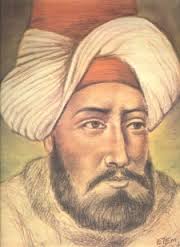Alternately argued as the reason for the decline of, or the reason for the longevity of the Ottoman Empire, the Sultanate of Women was a 130 year period in which the Ottoman Empire was ruled by the Valide Sultan--or the Sultan's mother--either in place of or alongside the Sultan. It started with the marriage of Suleiman the Magnificent to Hurrem Sultan, whom we have discussed before, and ended with the death of Turhan Sultan in 1683.¹ This century was filled with sultans who were children or mentally incapacitated, and marked the shift from the Empire's expansion to its settling into a period of peace and prosperity.
The was, largely in part, due to the women of the Harem who did the actual ruling. Harem's are often painted as dens of lust and depravity, but that couldn't be farther from the truth. The harem was where the women of the Sultanate lived, including the Sultan's wives, concubines, mother, and sisters. It was also a place of assassinations, political machinations, and governing. Any foreign entity looking to treat with the Ottomans needed to go through the Harem first, and the Sultanas wielded tremendous influence. If you think that the women of the Ottoman Empire were delicate, repressed flowers, veiled and shut off from power, hold on to your hats--you're in for quite a ride.
The Valide Sultan exercised such great power in part because of the Islamic belief in the importance and power of mothers. The Prophet Mohammed's statement that 'Heaven lies under the feet of mothers' was taken very seriously, and as such the Sultan frequently put his mother in charge of the harem. It was the Valide who oversaw the running of an enormous household, and picked the women who would be going to her son's bed. She managed the thousands of people who worked in the palace, and ensured the safety, security, and tranquility of the palace.
The Valide wasn't confined to the domestic sphere, however. It was the Valide Sultan who negotiated with foreign ambassadors, and mediated between the sultan and religious leaders. The Valide served as regent in times of need, and she frequently counseled with the Pashas. She reached out to, and maintained relationships with foreign leaders. It was said of Hurrem, and the Sultana's after her, that if you wanted to gain an audience with the sultan, you had to go through his Valide.
It wasn't just religious belief that handed these women such power. A Valide Sultan could be weak and pushed aside the same as a Sultan. The Valide's who held power, and the Valide's of the Reign of Women were skilled politicians and stateswomen, capable of running a vast empire.
As mentioned, the Sultanate of Women started with the marriage of Hurrem Sultan to Suleiman the Magnificent in 1531. Hurrem was Suleiman's Haseki Sultan--or official wife--not the Valide Sultan, and was the only Sultana to exercised great power as Haseki.² Hurrem kicked off the Reign of Women by being one of the first Sultana's to maintain diplomatic and personal relationships with foreign monarchs. In addition to maintaining diplomatic relations, she was also known for her building and public work projects--another large part of being Valide Sultan. Hurrem was Suleiman's closest adviser, and he frequently deferred to her in matters of state.
Hurrem, unfortunately, never lived to be Valide Sultan, as she predeceased Suleiman. She was 'replaced' (as much as any beloved wife can be replaced) in Suleiman's confidences by their daughter Mihrimah. Mihrimah is another noted sultana from the era. She rode with Suleiman on his campaigns--touring and conquering. Like her mother, Mihrimah maintained diplomatic relationships with foreign monarchs, and because of her travels she was well known by even common people in foreign countries. When Suleiman died her brother, Selim II, installed her as Valide Sultan, making Mihrimah the first of the great Valide Sultans.
There were eight women who ruled during the Sultanate of Women, and we'll undoubtedly discuss each of them in their own 'Damn, Girl' post, but for the sake of brevity we'll only mention the most notable following Mihrimah here.
Nurbanu Sultan, wife of Selim II, Mihrimah's brother, was noted for her wisdom and intelligence. Like Hurrem, she was Selim's adviser during his life (though not as close an adviser as Mihrimah.). She was Selim's favorite wife, and it was understood that her son Murad--later Murad III--would become sultan. At the time of Selim's death Murad was away from Istanbul, leaving him vulnerable to a coup. She hid Selim's corpse in an icebox in the harem for twelve days, and didn't tell anyone he had died until Murad had arrived in the capital. Following her son's investiture, Nurbanu continued to more or less rule the empire through, and sometimes in spite of her son.
Kosem Sultan was Valide Sultan for 62 years, and saw the reign of six different sultans, and was the regent for three of them. Her eldest son--Murad IV--and her grandson--Mehemed IV--were both too young to rule when they came to the throne, and her second son--Ibrahim--was mentally ill. As regent, Kosem oversaw all matters of the empire, and attended cabinet meetings from behind a screen. She assisted in the installation and removal of sultans (she had her son Ibrahim deposed and executed), and helped clear out the corruption of the palace.
Kosem's daughter-in-law, Turhan Hatice Sultan, was the last of the great Valide Sultans. After Kosem's death in 1651, she served as regent for Mehemed IV. Turhan was, by far, the most powerful of the Valide Sultans. Not only did she listen to cabinet meetings from behind a screen like Kosem, but she also spoke from behind the screen, taking an active part in cabinet meetings. After her son reached the age of majority she continued to co-rule the empire with her son's consent. She was instrumental in modifying the government structure of the Ottoman Empire, which gave the Grand Vizier more power.
Following Turhan's death the power of the Valide Sultan began to die out. The increasing of the power of the Grand Vizier was in part responsible for this, but the larger part was the fact that the sultan following Mehemed--Suleiman II--didn't want to share power.
These women rose to prominence because of the weakness of the Sultan's at the time. Following Suleiman the Magnificent, the sultans became increasingly incompetent until the situation came to a head with Ibrahim. Rather than allowing the empire to crumble, the Valide Sultans took control of the empire, and saved the empire's collective turkey bacon. The 130 years that marked the Sultanate of Women were years that saw great prosperity and political stability for the Ottoman Empire. This was largely in part because of the remarkable women who ruled.
¹Given that the Ottoman Empire would survive for a little more than 200 years after the death of the last great Sultana, I think that the 'women-ruined-the-ottoman-empire' theory is easy to disprove.
²The Haseki Sultan held much less power, despite being the sultan's wife. It was only through becoming the mother of a sultan that a women could hold such power. Hurrem Sultan, and her daughter Mihrimah are notable exceptions.
Sources
The Woman Who Oversaw 3 Generations of the Ottoman Empire
Sultanate of Women
Ottoman Royalty's Most Powerful Woman: Kosem Sultan
Sultanate of Women: Various Dimensions of the Ottoman Harem
Harem and Ottoman Women
Kosem Sultan
Nurbanu Sultan
Turhan Hatice Sultan
Mihrimah Sultan
 |
| Turhan Hatice Sultan, the most powerful of the Valide Sultan's |
The Valide Sultan exercised such great power in part because of the Islamic belief in the importance and power of mothers. The Prophet Mohammed's statement that 'Heaven lies under the feet of mothers' was taken very seriously, and as such the Sultan frequently put his mother in charge of the harem. It was the Valide who oversaw the running of an enormous household, and picked the women who would be going to her son's bed. She managed the thousands of people who worked in the palace, and ensured the safety, security, and tranquility of the palace.
 |
| Mihrimah Sultan, the second Valide Sultan of the Sultanate of Women |
It wasn't just religious belief that handed these women such power. A Valide Sultan could be weak and pushed aside the same as a Sultan. The Valide's who held power, and the Valide's of the Reign of Women were skilled politicians and stateswomen, capable of running a vast empire.
As mentioned, the Sultanate of Women started with the marriage of Hurrem Sultan to Suleiman the Magnificent in 1531. Hurrem was Suleiman's Haseki Sultan--or official wife--not the Valide Sultan, and was the only Sultana to exercised great power as Haseki.² Hurrem kicked off the Reign of Women by being one of the first Sultana's to maintain diplomatic and personal relationships with foreign monarchs. In addition to maintaining diplomatic relations, she was also known for her building and public work projects--another large part of being Valide Sultan. Hurrem was Suleiman's closest adviser, and he frequently deferred to her in matters of state.
 |
| Ottoman Empire map |
There were eight women who ruled during the Sultanate of Women, and we'll undoubtedly discuss each of them in their own 'Damn, Girl' post, but for the sake of brevity we'll only mention the most notable following Mihrimah here.
Nurbanu Sultan, wife of Selim II, Mihrimah's brother, was noted for her wisdom and intelligence. Like Hurrem, she was Selim's adviser during his life (though not as close an adviser as Mihrimah.). She was Selim's favorite wife, and it was understood that her son Murad--later Murad III--would become sultan. At the time of Selim's death Murad was away from Istanbul, leaving him vulnerable to a coup. She hid Selim's corpse in an icebox in the harem for twelve days, and didn't tell anyone he had died until Murad had arrived in the capital. Following her son's investiture, Nurbanu continued to more or less rule the empire through, and sometimes in spite of her son.
 |
| Selim II |
Kosem's daughter-in-law, Turhan Hatice Sultan, was the last of the great Valide Sultans. After Kosem's death in 1651, she served as regent for Mehemed IV. Turhan was, by far, the most powerful of the Valide Sultans. Not only did she listen to cabinet meetings from behind a screen like Kosem, but she also spoke from behind the screen, taking an active part in cabinet meetings. After her son reached the age of majority she continued to co-rule the empire with her son's consent. She was instrumental in modifying the government structure of the Ottoman Empire, which gave the Grand Vizier more power.
 |
| Kosem Sultan |
These women rose to prominence because of the weakness of the Sultan's at the time. Following Suleiman the Magnificent, the sultans became increasingly incompetent until the situation came to a head with Ibrahim. Rather than allowing the empire to crumble, the Valide Sultans took control of the empire, and saved the empire's collective turkey bacon. The 130 years that marked the Sultanate of Women were years that saw great prosperity and political stability for the Ottoman Empire. This was largely in part because of the remarkable women who ruled.
¹Given that the Ottoman Empire would survive for a little more than 200 years after the death of the last great Sultana, I think that the 'women-ruined-the-ottoman-empire' theory is easy to disprove.
²The Haseki Sultan held much less power, despite being the sultan's wife. It was only through becoming the mother of a sultan that a women could hold such power. Hurrem Sultan, and her daughter Mihrimah are notable exceptions.
Sources
The Woman Who Oversaw 3 Generations of the Ottoman Empire
Sultanate of Women
Ottoman Royalty's Most Powerful Woman: Kosem Sultan
Sultanate of Women: Various Dimensions of the Ottoman Harem
Harem and Ottoman Women
Kosem Sultan
Nurbanu Sultan
Turhan Hatice Sultan
Mihrimah Sultan




